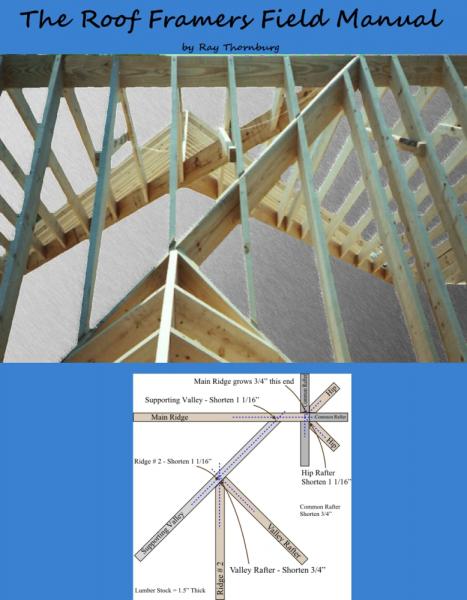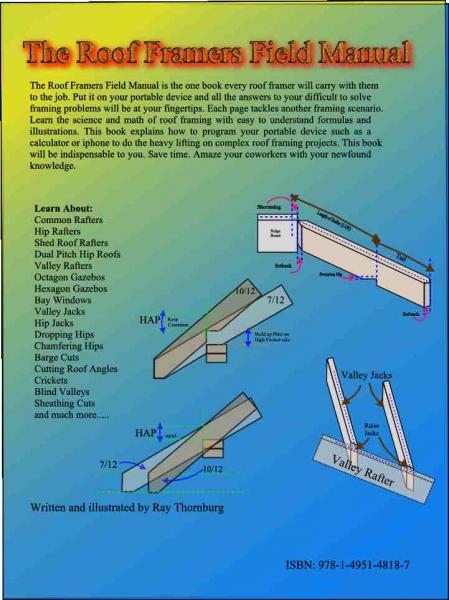- Home - Blue Palmetto Home Inspection of Summerville and Charleston
- Learn About Us and This Charleston Home Inspector
- What's Inspected
- Charleston Lowcountry Inspection Areas (geographic)
- Testimonials
- >>>Blogs (educational)
- Sample Reports & Documents
- Why Get a Home Inspection Report
- Charleston's Top Ten Reasons
- Home Inspector Photo Galleries
- Pricing
- Scheduling and Customer Information
- Home Inspection Authorization Contract
- General Scope of Work (electronic)
- Home Inspection Customer Satisfaction Survey
- Privacy Policy
- Full site
- The Roof Framers Field Manual
How to frame a cricket
Submitted by Ray Thornburg on Tue, 07/19/2011 - 14:14
How to Frame a Cricket
For those of you who don’t know, a cricket is a type of rain diverter that sets behind a chimney. It is like a small roof.
To begin you must know the pitch of the existing roof which is usually expressed as inches per foot of run. For example 8/12 roof will be 8 inches vertical to 12 inches horizontal. Assume that we have a chimney which is four foot wide. Also assume that the pitch is a 12/12.
Always frame the cricket at the same pitch as the roof and you will be within code guidelines. This also makes it easier. Ok ….so a four foot wide chimney has a span of 4 foot and half of that is the run which is 2 foot. This is the number which we will use to lay out our rafter for the cricket. It is also the length of the ridge(before deductions) and the length of one side of the sheathing.
All we need to do now is determine the length of the cricket rafter per foot of run. On a 12/12 roof that number is 16.97. You can find this number on the framing square under the 12” mark on the first line of the rafter table labeled “length of common rafters per foot run”. We’ll round that number to 17 to make it easier. So 2 x 17=34”, which is the length of our rafter and also the length of the sheathing on the chimney side. Cut a mirror image pair of rafters with a 12/12 plumb cut at the top and a 12/12 level cut at the bottom with a 45 degree bevel. Cut two triangular pieces of plywood 24” long by 34” wide. Now if you want a little ridge board you’ll have to subtract half the thickness of the ridge measured horizontally on each rafter and (subtract half the ridge thickness from the ridge length).
If your run happens to be a odd unit like 2’ 3 ½ “ convert the inches to feet by dividing by 12 before you perform your other calculations…..for example 3 ½ becomes 3.5 /12 = .2916. Next add the run 2.296 x 17 =39.032” the new length of our rafter. Click image to enlarge.
So the steps are:
- Dertermine the pitch.
- Determine the run (1/2 width of chimney).
- Lay out rafter to the run using the same pitch as the roof.
- Cut the plywood to the length of the rafter on one side and the ridge length on the other (run length).
- Deduct for 1/2 ridge thickness from the rafter and ridge if you're using one.
- Consider buying my book "The Roof Framers Field Manual" to learn more about roof framing.
Current rules state that crickets are needed for any chimney over 30" wide as long as it doesn't intersect the ridge line. references irc 2003 1001.17
Here is an example of a home without a cricket. Sometimes it appears that flashing like this is working . However inspection of attic areas revealed rotted sheathing and rafters around the chimney area which is the result of small amounts of moisture doing its damage over time. Also note that although this roof had been recovered the roofers failed to install a cricket or other flashing in this area. This is because consumers often make economically driven choices for contractors and most roofing contractors will replace only the roof covering. So make sure you specify that you want defective flashing replaced and crickets installed where required.
Here is a picture of a cricket properly installed and doing its job.
Learn the science and math of roof framing. My book The Roof Framers Field Manual has it all.

 Click the links to go to my buy it now page!
Click the links to go to my buy it now page!


